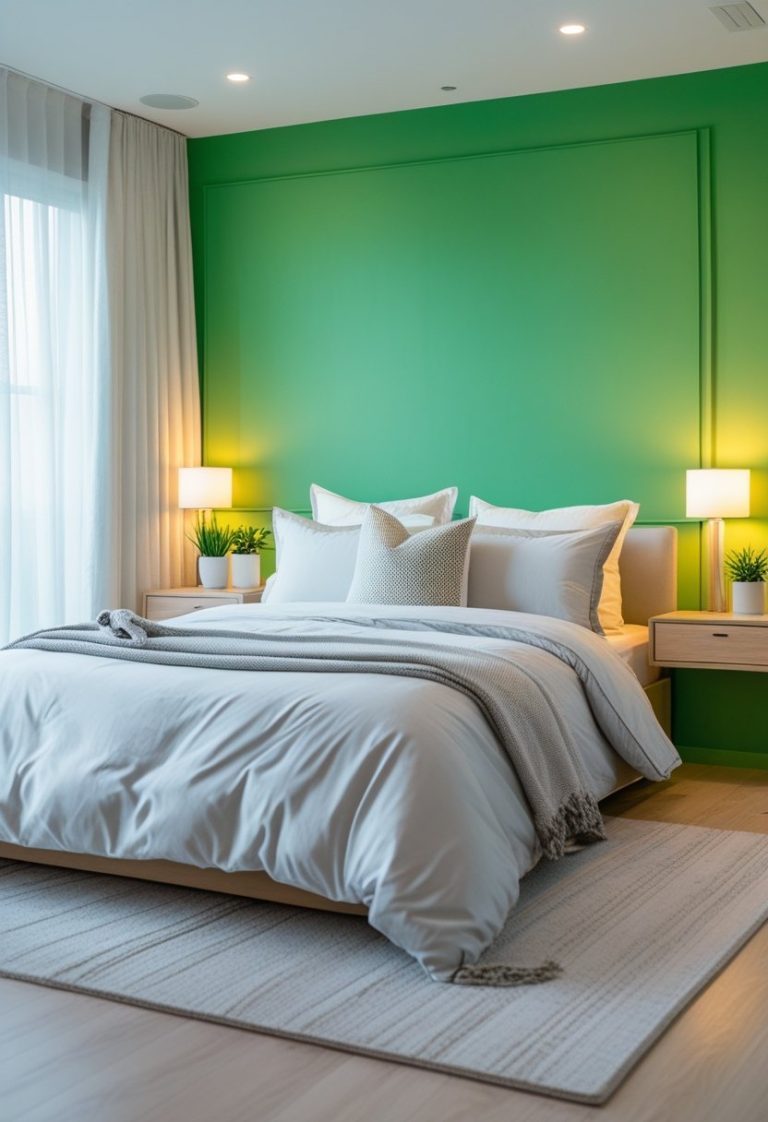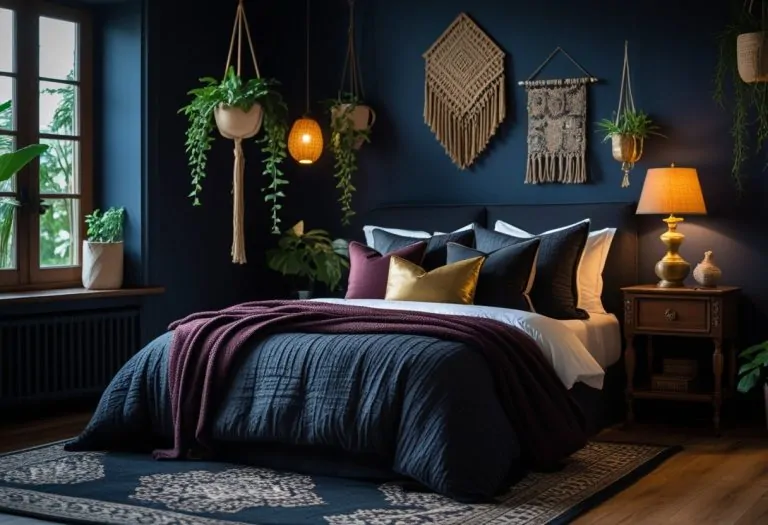Wooden Door Design Trends and Tips for Modern Homes 2025
Wooden door design combines functionality with aesthetic appeal, making it a popular choice for both interior and exterior spaces. It offers a wide range of styles, from minimalist to intricate geometric patterns, allowing homeowners to match their doors with various architectural themes. The material itself provides durability and a timeless look that can enhance any home’s entrance or room.

The key to selecting a wooden door design lies in balancing style, wood type, and hardware to suit specific needs and preferences. Whether opting for rustic, modern, or custom-made designs, wooden doors allow for creative expression while ensuring security and insulation. Their adaptability makes them suitable for different budgets and home styles.
Beyond beauty, wooden doors come with practical benefits such as soundproofing and energy efficiency. By exploring various designs and materials, one can find solutions that elevate the home’s overall atmosphere and increase its value.
Types of Wooden Door Designs

Wooden door designs vary widely in their structure, appearance, and functionality. They can be tailored to match different architectural styles, durability needs, and aesthetic preferences. Some focus on simple flat surfaces, while others use intricate framing or openings for airflow.
Panel Doors
Panel doors are made by fitting solid wood panels into a frame, creating a segmented look. The panels can vary in number and shape, often rectangular or square, providing visual depth and texture.
This design is strong because the frame supports the panels, which can expand or contract without warping the entire door. Panel doors suit traditional and modern interiors, and they can include glass or decorative inserts.
Common applications include front doors and interior doors where style and durability are essential. The design allows for customization with different wood types and finishes.
Flush Doors
Flush doors have a smooth, flat surface with no panels or grooves. The core is often made of solid wood blocks, plywood, or composite materials, covered by a veneer or laminate.
They are minimalist and fit well in modern or contemporary spaces requiring simplicity and clean lines. Flush doors are usually lighter and more affordable compared to panel doors.
These doors offer good insulation when made with solid cores and have a uniform appearance that can be painted or stained easily. They work well in both interior and exterior settings depending on material quality.
Battened and Ledged Doors
Battened and ledged doors consist of vertical wooden planks (battens) joined by horizontal crosspieces (ledges). This construction reinforces the door and prevents warping.
Traditional in style, these doors are commonly used for outbuildings, barns, or rustic interiors. Their straightforward design makes them easy to build and repair.
They emphasize durability over decoration, often left with natural wood finishes or painted for weather resistance. The visible joints and hardware add to their characteristic rustic appearance.
Louvered Doors
Louvered doors feature angled slats, usually horizontal, that allow ventilation while maintaining privacy. These slats can be fixed or adjustable.
Ideal for closets, utility rooms, and areas needing airflow, louvered doors reduce moisture buildup and odors. They can be solid wood or framed with wooden slats.
Their design balances function and style, fitting well in tropical climates or homes requiring air circulation. Louvered doors come in varied slat widths and spacing to suit different lighting and ventilation needs.
Popular Wooden Door Styles

Wooden doors come in a variety of designs tailored to different architectural tastes and functional needs. Key considerations include the door’s finish, panel arrangement, and hardware, all of which influence both appearance and durability.
Contemporary Wooden Doors
Contemporary wooden doors emphasize clean lines and minimalist design. They often feature smooth surfaces, large glass inserts, or metal accents, creating a sleek look suitable for modern homes.
Materials like engineered wood or hardwood with a natural finish are common. These doors focus on functionality with energy efficiency and security enhancements, such as multi-point locking systems. Their simple, uncluttered appearance allows for versatility in various color schemes and interior styles.
Traditional Wooden Doors
Traditional wooden doors typically showcase detailed craftsmanship through raised or recessed panels, molding, and classic joinery. They often use rich hardwoods like mahogany, oak, or cherry to highlight natural grain patterns.
These doors might include ornate carvings or decorative glass panes, enriching a home’s character and charm. They are popular in older or colonial-style homes where historical accuracy and warmth are priorities.
Rustic Wooden Doors
Rustic wooden doors prioritize natural textures and raw finishes, emphasizing knots, imperfections, and rugged surfaces. They frequently use reclaimed wood or rough-sawn timber to create a handcrafted, earthy appeal.
Design elements include heavy iron hardware, visible nails, and robust frames. Rustic doors fit well in farmhouse, cabin, or cottage-style settings, offering durability and a connection to traditional building methods.
Material Selection for Wooden Doors
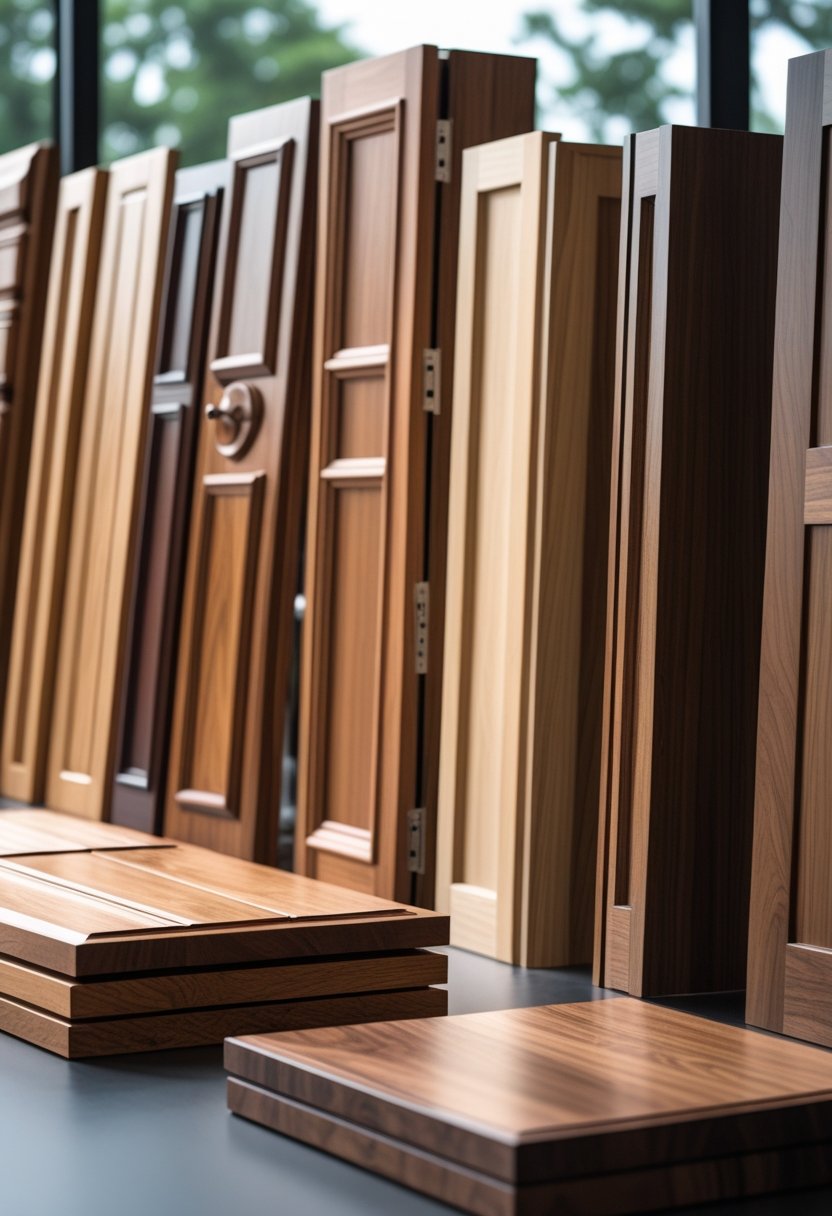
Choosing the right wood affects a door’s durability, appearance, and maintenance needs. Various options offer different balances of strength, grain patterns, cost, and environmental impact.
Solid Wood Options
Solid wood doors come from a single species and provide natural beauty and strength. Common choices include oak, mahogany, maple, and cherry, each with distinct grain and hardness.
Oak is dense and durable, resistant to wear and dents, making it suitable for high-traffic areas. Mahogany offers a rich, reddish color and excellent stability in varying climates. Maple and cherry bring smooth grain and warm tones but may require more maintenance to prevent dents and scratches.
Solid wood is generally more expensive but allows for refinishing and long-term repairs. It can expand or contract with changes in humidity, so proper sealing is essential to prevent warping.
Engineered Wood Choices
Engineered wood doors combine wood layers with adhesives for greater stability. Options include plywood, MDF (medium-density fiberboard), and laminated boards.
These doors resist warping and moisture damage better than solid wood, making them ideal for humid or unstable environments. They are often more affordable and allow for consistent surface finishes.
MDF has a smooth surface ideal for painted doors but lacks wood grain texture. Plywood offers strength and can showcase veneers of high-quality wood for aesthetic appeal. Engineered doors generally require less maintenance but cannot be refinished like solid wood.
Sustainable Wood Types
Sustainable wood focuses on environmental responsibility without sacrificing quality. Certified woods from responsibly managed forests, such as FSC (Forest Stewardship Council) certified species, are common.
Bamboo, although technically a grass, is a fast-growing sustainable option offering strength and modern appeal. Reclaimed wood is also popular for its character and reduced environmental impact.
Selecting sustainable wood helps reduce deforestation and supports ecosystem health. These materials are increasingly used in custom doors to align with green building standards while maintaining door performance.
Finishes and Treatments

Finishing and treating wooden doors is essential to protect them from weather and wear while enhancing their natural appeal. The choice of finish impacts durability, maintenance, and the door’s final look.
Varnished Finishes
Varnish creates a hard, clear coating that shields wood from moisture, UV rays, and temperature changes. It tends to highlight the wood’s natural grain, offering a glossy or satin finish depending on the product used.
Application requires a clean, smooth surface and multiple thin coats for best results. Once cured, varnish is durable and resists cracking or peeling. It is ideal for entry doors exposed to direct sunlight or heavy rain.
Maintenance involves occasional cleaning and reapplication every few years. A high-quality spar varnish or polyurethane varnish is recommended for exterior use to ensure long-term protection.
Painted Designs
Painting wooden doors offers endless customization in color and style. Paint forms a solid barrier against water and UV damage, but it hides the natural wood grain.
Proper preparation, including sanding and priming, ensures a strong bond. Exterior-grade, weather-resistant paints with elastomeric properties will accommodate wood’s natural expansion and contraction without cracking.
Paint also allows for decorative detailing or patterns. Repainting is required more frequently than varnish, typically every 3 to 5 years depending on exposure.
Stained Effects
Staining penetrates wood, enhancing its texture and color while preserving the grain’s visibility. Stains vary from transparent to semi-solid, altering appearance without hiding natural features.
Stains protect against moisture and sunlight but generally require an additional clear topcoat, such as varnish or polyurethane, for maximum durability.
Wood species and stain type affect final results, so testing on a sample is advisable. Stained finishes balance aesthetics with protection and are popular for traditional or rustic door designs.
Design Elements and Decorative Features
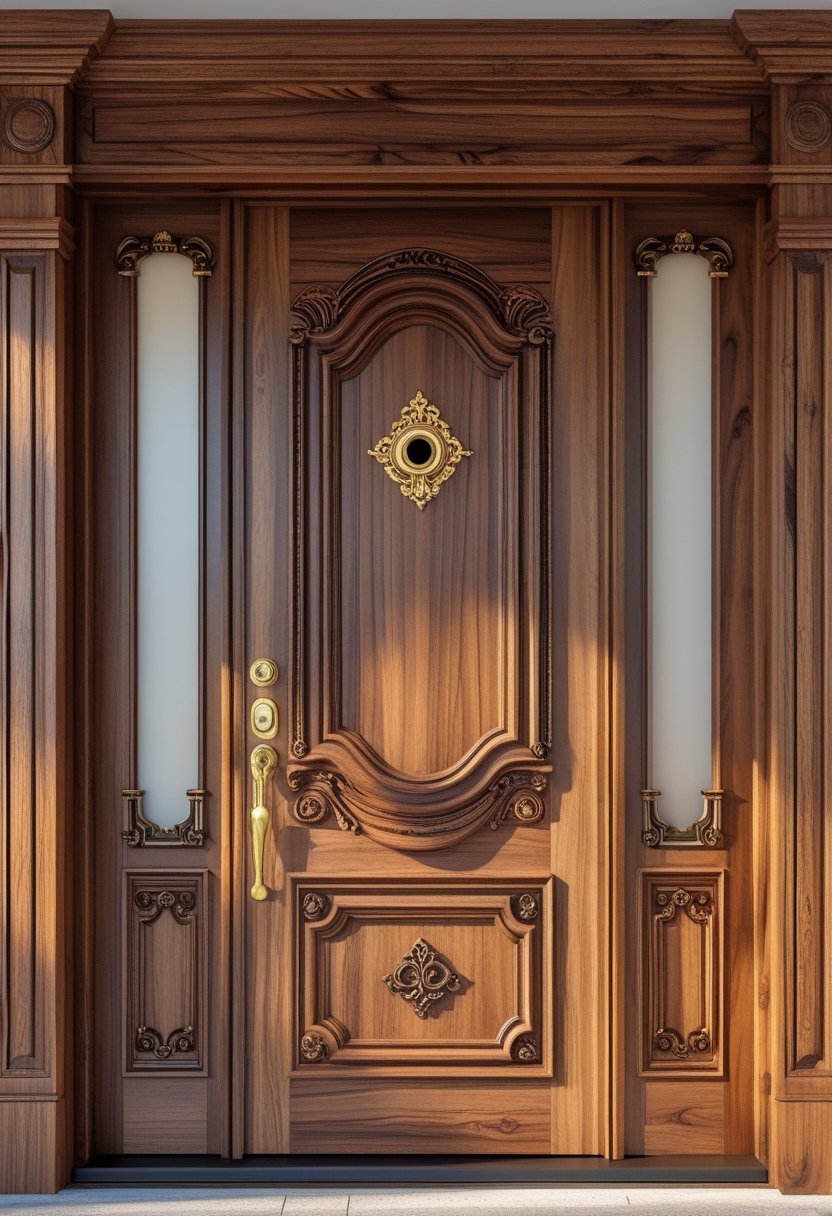
Wooden doors often combine various design details that enhance both function and aesthetics. Key components include surface textures, visual transparency, and material contrasts. These elements work together to tailor the door’s style to its environment and intended use.
Carvings and Patterns
Carvings add dimension and artistic detail to wooden doors. They can range from simple geometric lines to complex floral or jaali (lattice) patterns. Carved doors often highlight traditional craftsmanship, making them suitable for homes seeking a blend of heritage and sophistication.
Patterns influence the door’s character by directing how light and shadow interact on the surface. Fluted panels or recessed motifs create subtle texture without overwhelming the design. Precision in carving is crucial for balance and durability, especially in external doors.
Glass Inserts
Glass inserts introduce light and openness to wooden doors while maintaining privacy through frosted, tinted, or textured glass options. They range from small accent panels to full-length panes, often framed by wood or metal.
Modern designs favor minimalist, clear glass for a sleek look, while traditional styles use stained or beveled glass to add color and detail. Glass enables visual connection between indoors and outdoors, improving natural light flow without sacrificing security or insulation when properly treated.
Metal Accents
Metal accents such as handles, hinges, and decorative strips add contrast and strength to wooden doors. Popular metals include brass, stainless steel, and wrought iron, each chosen for both durability and aesthetic appeal.
Brass elements can evoke a vintage or classic feel, while sleek stainless steel suits modern interiors. Metal can also frame or highlight carvings and glass, integrating all elements into a cohesive design. Functionally, metal hardware improves security and usability.
Hardware and Accessories for Wooden Doors

The choice of hardware and accessories greatly affects the functionality, security, and style of wooden doors. Selecting the right components involves balancing durability, material quality, and compatibility with the door’s design.
Handles and Knobs
Handles and knobs are the most frequently used hardware components on wooden doors. They come in various materials such as solid brass, stainless steel, and high-quality alloys, chosen for longevity and resistance to wear.
Style options include traditional round knobs, modern lever handles, and decorative pulls. The finish, like satin nickel, antique bronze, or polished brass, should match other hardware elements and the door’s overall aesthetic.
Properly designed handles ensure ease of operation and complement the door’s design. Priority should be given to ergonomic forms and durable finishes to reduce maintenance and enhance user comfort.
Locks and Hinges
Locks secure wooden doors and come in several types: deadbolts, mortise locks, and latch locks. The right lock depends on the door’s purpose and security needs. Solid hardware materials extend lock life and improve safety.
Hinges support the door’s weight and allow smooth opening and closing. Heavy-duty, corrosion-resistant hinges—made from materials like stainless steel or brass—are essential for durability.
Both locks and hinges must be compatible with the door’s weight and thickness. Proper installation prevents misalignment and wear, preserving door function and security over time.
Peepholes and Doorbells
Peepholes add a security feature by allowing occupants to see outside without opening the door. They are available in various viewing angles and finishes to match door hardware.
Doorbells, either wired or wireless, can be installed near wooden doors to notify residents of visitors. Modern designs often include video and intercom features, increasing security and convenience.
Placement of peepholes and doorbells should maximize usability and integrate smoothly with other hardware to maintain the door’s visual appeal and functional balance.
Custom and DIY Wooden Door Inspiration
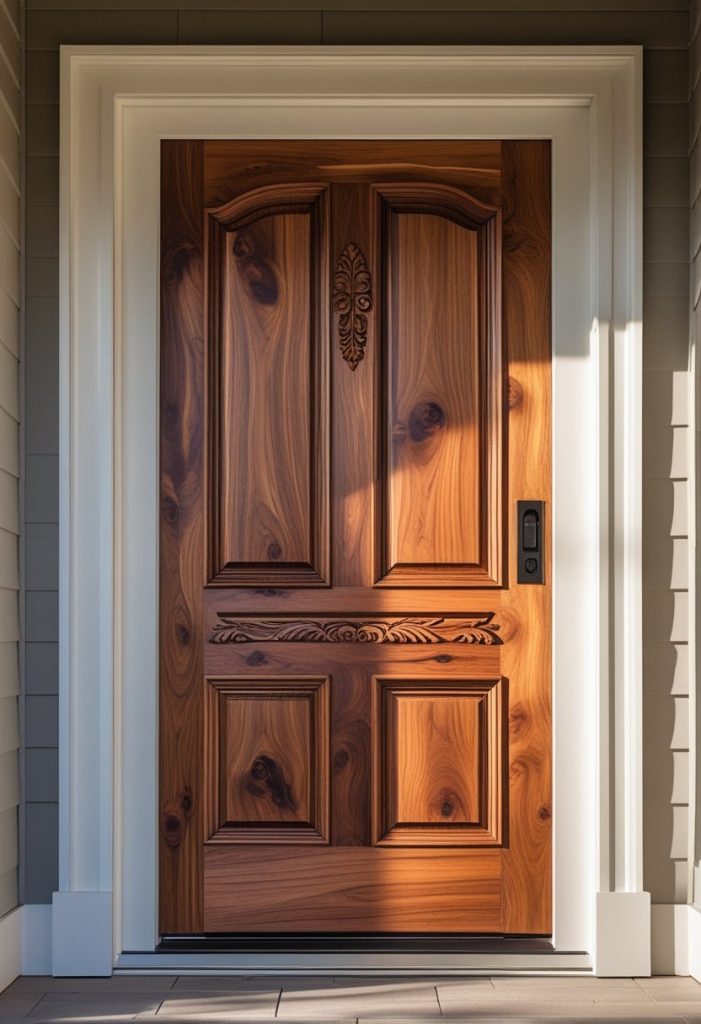
Creating custom wooden doors involves blending personal style with practical techniques. This includes adding unique details, using sustainable materials, and finding new uses for old elements. Each approach enhances the door’s character and functionality.
Personalized Engravings
Engravings add distinctive detail and personality to wooden doors. They can range from simple patterns to intricate designs or meaningful symbols.
Choosing the right engraving style depends on the wood type and door design. Softwoods like pine are easier to carve, while hardwoods such as oak offer more durability. Tools range from hand chisels to CNC machines for precise cuts.
Engravings often highlight the door’s grain pattern, enhancing visual interest. They can serve functional purposes too, like numbering or labeling rooms in a home or business.
Reclaimed Wood Projects
Reclaimed wood offers a sustainable option with natural character. Doors made from reclaimed wood often display unique grain patterns, knots, and color variations not found in new timber.
This wood may come from old barns, factories, or demolished buildings. Proper preparation includes cleaning, treating for pests, and ensuring structural integrity.
Using reclaimed wood requires adjustments to fit modern door frames, sometimes combining pieces for size and strength. Its environmental benefits appeal to those seeking eco-friendly building materials.
Upcycling Ideas
Upcycling transforms old doors or wood into new functional designs. This approach extends material life and reduces waste.
Common upcycling projects include refinishing old doors with new hardware, paint, or glass inserts. Adding features like chalkboard panels or decorative molding can refresh the look.
Upcycled doors can serve as room dividers, headboards, or garden gates beyond their traditional use. The focus lies in creatively adapting existing materials while maintaining durability.
Maintenance and Care Tips
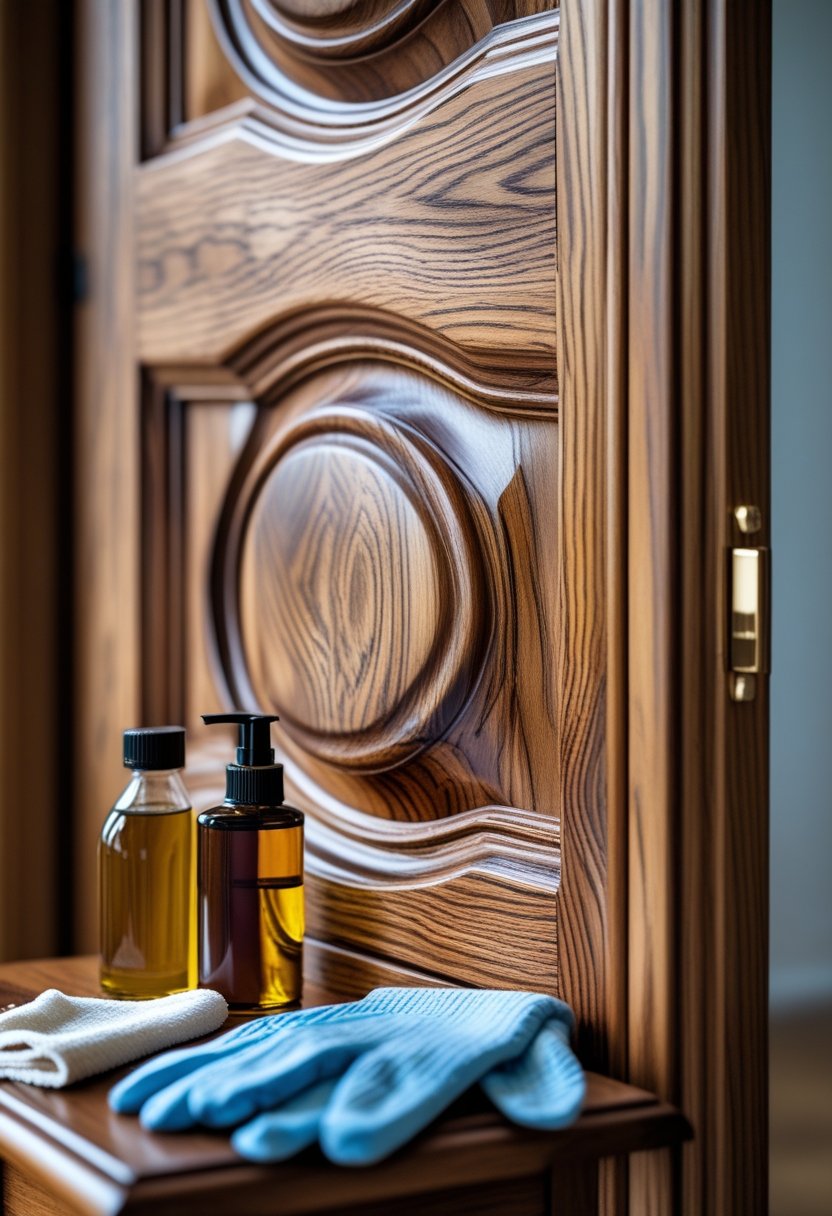
Wooden doors require regular attention to maintain their appearance and functionality. The first step is cleaning the door gently with a soft cloth and mild detergent to remove dirt and prevent grime buildup.
Inspecting the door regularly for signs of warping, cracks, or moisture damage helps catch problems early. Small repairs can prevent larger, more costly issues later.
Applying protective coatings like varnish or sealant every 1-2 years is essential. This process safeguards the wood from moisture, UV damage, and general wear.
Hardware such as hinges and handles should be checked frequently. Lubricating moving parts and tightening screws ensure smooth operation and prevent rust.
Seasonal adjustments are important. In dry months, a light application of wood oil can prevent drying and cracking. During wet seasons, paying extra attention to seals and gaps will reduce moisture infiltration.
| Maintenance Task | Recommended Frequency |
|---|---|
| Cleaning | Monthly or as needed |
| Inspection | Quarterly |
| Protective Coating | Every 1-2 years |
| Hardware Lubrication | Every 6 months |
| Seasonal Wood Treatment | Twice a year (dry and wet seasons) |
Consistent care extends the life of wooden doors and maintains their natural beauty. Following these practical steps will ensure doors remain both functional and visually appealing over time.
Cost Factors and Budgeting

Several factors influence the cost of wooden doors, and understanding them helps in creating a realistic budget.
The type of wood is a primary determinant. Solid hardwoods like oak or mahogany typically cost more than softwoods such as pine or fir due to durability and aesthetic value.
Design complexity also affects price. Intricate carvings, glass inserts, or custom shapes increase manufacturing time and materials, raising the cost.
Size and thickness matter as larger and thicker doors require more material and labor, which can significantly impact the overall expense.
Additional expenses include:
- Hardware (locks, handles, hinges)
- Finishing treatments (stains, paint, sealants)
- Installation fees
These can vary widely based on quality and service provider.
Budgeters should consider long-term maintenance costs, as some wood types and finishes require regular care to preserve their appearance and functionality.
Below is a simple cost factor overview:
| Factor | Impact on Cost |
|---|---|
| Wood Type | High (varies by species) |
| Design Complexity | Medium to High |
| Size & Thickness | Medium |
| Hardware | Low to Medium |
| Finishing Treatment | Low to Medium |
| Installation | Medium |
By examining these components, one can allocate funds effectively and select a wooden door that fits both style and budget requirements.
Current Trends in Wooden Door Design
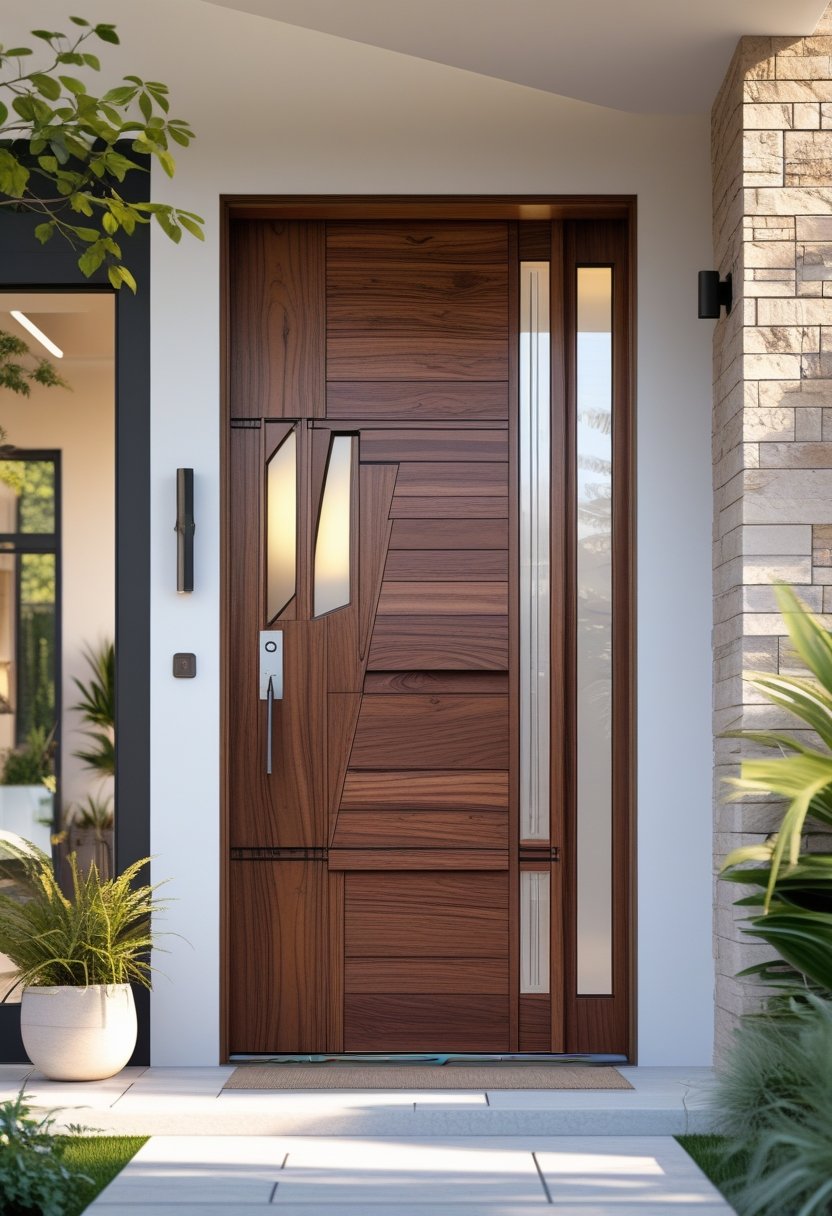
Wooden door design in 2025 emphasizes both style and sustainability. Homeowners are increasingly choosing doors made from eco-friendly and sustainable materials. This reflects a growing awareness of environmental impact combined with a desire for durable, high-quality products.
Minimalism remains popular. Clean lines and simple forms offer a modern look that fits many architectural styles. Dark wood tones, such as walnut and ebony, are favored for their rich, elegant appearance.
Smart door technology is another growing trend. Features like keyless entry, integrated cameras, and remote locking provide added convenience and security without compromising design.
Aesthetic details play a key role. Arched doorways and glass accents are widely used to add character. They blend traditional craftsmanship with modern functionality, enhancing curb appeal.
Several design elements stand out:
- Bold patterns and refined color combinations
- Double entryways for grandeur
- Custom finishes for personalization
Overall, wooden doors balance timeless style with innovative features. They allow customization while maintaining practical benefits like durability and insulation. This makes them a preferred choice for homeowners focused on both form and function.




